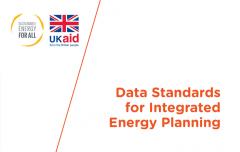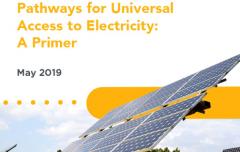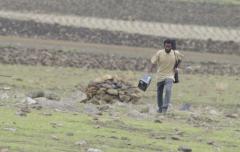Improved energy data: An unsung hero for SDG7 progress
The world has already seen the power of integrated energy planning for delivering new energy access to previously underserved populations. National electrification plans in countries like Ethiopia, Togo or Nepal have harnessed integrated approaches and delivered impressive results.
One of the pillars of integrated energy planning is the use of geospatial modelling. Technologies like geographic information systems (GIS), satellite imagery and machine learning allow for fast, cost-effective and visually powerful modeling of optimal energy pathways that clearly define the role of utilities, mini-grid and off-grid solar companies and clean cooking solution providers in expanding energy access.
Even though geospatial modeling is recognized as a powerful tool, its increasing adoption has highlighted a key challenge: data gaps and data quality. As with any modeling exercise, geospatial models are only as good as the data and assumptions on which they are based. Sound data provides the evidence decision-makers (e.g. energy planners, investors and companies) need to act.
Current energy data shortcomings holding back the implementation of integrated energy plans include:
- Accessibility - Important datasets such as energy demand, willingness and ability to pay, fuel supply chains, the location and energy needs of public institutions and productive uses are often unavailable or incomplete. Meanwhile, open access data are typically only available at low spatial and/or temporal resolutions, granular data are usually harder to attain and often come at a cost. For example, while data on high-voltage (HV) lines is publicly available, data on medium-voltage (MV) or low-voltage (LV) networks (e.g. distributed generation) typically aren’t.
- Reliability – Open source datasets raise questions around how/by whom they were produced and whether they are up to date. Even private datasets are not updated regularly enough for decision-makers to act upon them or to monitor progress.
- Overlooking cooking – There is a dearth of nationally representative, verifiable data for cooking supply (e.g. fuel availability and supply chains) and demand (ability to pay; fuel preferences; willingness to adopt new cooking technologies and fuels) in energy-deficit countries.
Recognizing these challenges, Sustainable Energy for All (SEforALL) hosted a workshop series about data and integrated energy planning in July 2020. The workshop brought together 65 participants, representing 28 organizations involved in generating, analysing or using data for energy planning purposes to explore how geospatial-based integrated energy planning can be made more accurate, consistent and practical through better data.
Through a series of five meetings, several principles emerged that should guide the development of new energy data standards:
- Closer attention to the demand-side: Energy planning has traditionally focused on the supply-side, with attention paid to technologies such as the central grid. Demand-side considerations are often overlooked or simplified. To ensure that integrated energy planning is effective and meets the needs of people, demand should be reflected in planning (both for electrification and clean cooking). This should be done through investments in demand-side data such as detailed information on ability and willingness to pay, productive uses, electricity growth and demand heterogeneity.
- Dynamic data: The inputs and data that inform energy planning are dynamic. For example, technology costs can evolve rapidly, due to learning curves and innovations, and can change significantly as economies of scale are leveraged. As planning exercises can span multiple years, if not decades, it is important to consider the dynamic nature of data and build planning systems that adapt accordingly.
- No copy-and-paste solutions: Data quality needs vary based on the intended use of the planning/modeling exercise. For this reason, it is important to identify which stakeholders a planning/modeling exercise is intended for before defining what data might be needed and at what level of granularity/accuracy. Furthermore, planners should be pragmatic and think about the optimal level of data quality in terms of the minimum data attributes or characteristics (e.g. granularity) that generate similar insights to those that might be gained with more ‘perfect’ data.
- Commit to clean cooking data and analysis: Geospatial integrated planning can help the clean cooking sector by serving as a central framework for stakeholders to rally behind and facilitating operational-level or technology/fuel specific decision-making. Meeting this potential will require substantial investments and improvements in cooking data and analysis. The beginnings of a geospatial integrated cooking framework can catalyse these commitments.
- Improved understanding of electric cooking: As advances in electric cooking spur the convergence of electrification and clean cooking, it is important that planners and power suppliers (e.g. utilities, mini-grid developers, SHS providers) better understand the implications of greater electric cooking adoption on energy demand.
- Harness low-cost solutions: While on-the-ground data collection will remain important, we should be looking to exploit advances in remote sensing and analytics, which are making it easier to obtain planning data and information at increasing levels of granularity and across a wider set of geographies. Cell phone-based surveys and remote monitoring are cost-effective ways of filling data gaps, especially as it relates to understanding consumer preferences and energy consumption.
These principles, and more, are examined in greater detail in a Workshop Report. Workshop outcomes will feed into a set of best practices developed by SEforALL on how governments, their development partners and the private sector can collaborate on improving energy data standards for integrated energy planning.




